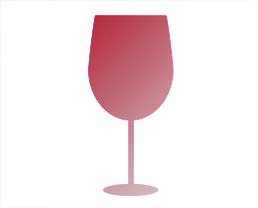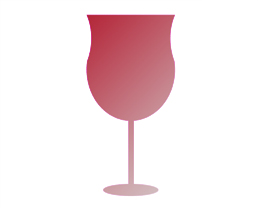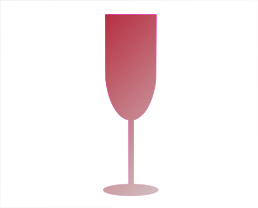Mateus Rosé - Vinho de Mesa
Served at 7:16 PM on Thursday, April 17, 2008
Recently, at a neighborhood wine store, I found something that was locked inside(what I want to describe as) an unusual bottle, a sort of flask. Unusual because it looked a class apart. It looked to be a part of the bygone era of the 70s, but had the feel of an modern wine bottled in old-world charm.
The look of it almost seduced me into buying it. With words such as Vinho de Mesa(table wine), Portugal and Rosé I was overwhelmed by the mixed reactions it could evoke. On one side I was making up an exotic world, retro and all, and on the other I was thinking perhaps this is going to be a not-so-good-experience. So wrong I was about the latter!
Some History
MATEUS Rosé’s story goes back to 1942 when Fernando Van Zeller Guedes, SOGRAPE’s founder, created and launched an entirely new concept, combining innovative elements within the different variables of the marketing mix.
Fernando Van Zeller Guedes was convinced that it was possible to make attractive and internationally interesting wines in Portugal. To that end, it was necessary to offer the market a wine that would be different from the others, especially the French ones.
Using technology that was an innovation at the time, the decision fell on a pink-coloured wine, made from red grapes from the Douro region.
MATEUS Rosé’s true secret – the one which gives it its distinct pink colour and great versatility – lies in the oenological care that goes into its making. Made exclusively from Portuguese red-grape vine varieties, such as Baga, Rufete, Tinta Barroca and Touriga Franca, its vinification process, involving a long fermentation period at controlled temperature, uses techniques similar to those used in the making of white wine. Avoiding a prolonged contact between the must and the skins, the wine acquires its distinct pink colour and retains a soft and fruity style.
Light, young, fresh and slightly fizzy, this wine has a great drinking versatility and is an excellent alternative to a glass of champagne or, simply, to a glass of beer. Seafood, fish, Chinese cuisine and light meals by and large go particularly well with MATEUS.
As regards the packaging for such a wine, originality was the key-word: the decision fell on a low and squat bottle, inspired by the flasks used by soldiers during World War I, a shape that made it stand out from other, taller bottles, in the shelf; the label, noble and innovative for the time, showed the Palácio de MATEUS, a baroque manor house, and provided a link between the product and its land of origin.
An innovative concept had been born, the competitive advantages of which were five-fold: the Mateus brand, the label portraying the palace of the same name, the use of an innovative bottle, all associated with the quality and organoleptic characteristics of the wine and with the image that gradually became part of it, constituted some of the variables that came to be the brand properties and that quickly made Mateus a world-wide known and enjoyed brand.
And that is how the MATEUS Rosé brand came about, along with its road to success.
The Wine
MATEUS ROSÉ is a light, fresh, young and slightly fizzy wine. Its quality, extreme versatility and consistent style make it the ideal wine to accompany a variety of cuisines and occasions.
Tasting Notes
MATEUS ROSÉ is a rosé with a very appealing and bright hue. On the whole, it is a fresh and seductive wine with fine and intense bouquet and all the perkiness of young wines. Roll it in the mouth and one realizes that it is a well balanced and tempting wine, brilliantly complemented by a soft and slightly fizzy finish.
Labels: Blush, entrée, floral, Portugese, Rogue, Rosé, table wine, tasting notes
Wine thing to know - Ampelography
Served at 9:54 AM on Wednesday, April 09, 2008
New interest drives one to seek more about the subject. Fork and Cork wants to get you revved up with just the right stuff. We wanted to start something like "Wine term of the day" or something similar, but then we realized, it could even be an "Interesting Wine Fact". Well then, we have them clubbed together and decided to call it "Wine thing to know".
And the WTTK this time is Ampelography! What a mouthful, you may say. But wait till you get to know what it is.
Ampelography (Ampelos, 'vine' + graphy, 'writing') is the field of botany concerned with the identification and classification of grapevines. Traditionally this has been done by comparing the shape and colour of the vine leaves and grape berries. In recent times, vines are studied using even DNA fingerprinting!
And the WTTK this time is Ampelography! What a mouthful, you may say. But wait till you get to know what it is.
Ampelography (Ampelos, 'vine' + graphy, 'writing') is the field of botany concerned with the identification and classification of grapevines. Traditionally this has been done by comparing the shape and colour of the vine leaves and grape berries. In recent times, vines are studied using even DNA fingerprinting!
Labels: interesting, Wine-thing-to-know
New Zealand Wine Travel
Served at 10:48 PM on Tuesday, March 11, 2008
The above is a teaser video around Wine Tourism(or wine-related travel, if you'd like to call it that) in New Zealand. It shows a second-generation NewZealander called Rebecca going around on her scooter to get a whiff of all things wine.
Well, with nice different growing regions, New Zealand wines offer great varietal characteristics due to subtle climate changes from the north to south of its islands. Fans of Sauvignon Blanc will be delighted by what many critics consider the world’s best. The country’s red wines, particularly pinot noir and cabernet/merlot blends, also receive recognition around the world.
If New Zealand as a Wine Travel destination excites you, you should try out Wineries at New Zealand.
We were away for sometime now, but we promise, we want to write more often in the time to come. Stay tuned, and be the Winetastic Foodaholic you folks have always been!
Labels: video, wine-tasting, wine-travel
Open A Bottle Of Wine Without Corkscrew
Served at 12:08 PM on Thursday, July 26, 2007
Sorin Mihailovici from Edmonton, Canada makes amazing videos. His passions are TV production and Wine, and he makes heady concoctions of both. He knows a neat trick which he has turned into a short video that he shares with Fork and Cork.
That's a neat one. Ain't it?
That's a neat one. Ain't it?
Labels: accessories, corkscrew, forkandcork, interesting, video
Chargrilled Vegetables with Herbs and Pepper Sauce
Served at 7:35 PM on Sunday, April 15, 2007
What you need:
1 long fork, preferably with a wooden grip
1 large floret of Cauliflower (This is almost 1/4th or 1/5th of the whole)
2 medium sized potatoes
1 large Capsicum
Tabasco® Sauce, Mild Jalapeno Flavor (The local variations of pepperico and Capsico will do)
2 teaspoons Ground Pepper or pepper powder
Curds (one medium-sized bowl)
Stir Fry sauce (If you have it around, otherwie not very necessary)
2 teaspoons Oregano, Basil and any other herbs that you'd like (dried, flakes)
Half onion, sliced longitudinally, very thin
How you make it:
Stab the Floret with the fork, and sprinkle olive oil. Put it on the gas flame or choolha on low blast and use a cooking mesh if you can. You can also put it on a real barbeque or grill it in a microwave. But the flame thingy adds more to the flavor. Cook till semi-cooked, we don't want it soft and mushy. Make sure that the florets are smoked well.
Do the same to the Potatoes. Keep the peel intact while you do so. It comes off very easily later. To figure out how deep has the potato been done, just poke in a sharp knife and let it glide in smoothly. When it goes through, or at least till the core without much effort, get 'em off the flame.
Repeat the same with the Capsicum. Perforate the Capsicum on the sides with the Fork. You don't want it to go 'phut'. Then follow the same as above. Allow it to cook till it develops that smoked aroma, and becomes a little tender.
Separate the florets, as small as you'd like them to be. Peel and Sliver the potatoes, and keep watching for a color change near the core. This is the portion not well done. You could discard it or use it for another preparation later. Thin slice the Capsicum.
Now for the Sauce:
Sprinkle a hot wok with olive oil. Add the thinly sliced onion. Sautée till gold, but not crisp. Add a little stir fry sauce if available. Add the Tabasco®, just a few dashes. Add the herbs, and keep the tossing on. Just before the aroma is about to die out, splatter the pepper. Add salt to taste. Add the Chargrilled vegetables. Cook till the flavor sets in, keep it dry. Add the curds. Bring the wok out of the flame. Mix the contents off the flame.
Note: You can use very little of curds if you plan to use this preparation as a starter.
And Voila! You're all set to go!
This tongue-tickler goes well with risotto, or plain white steamed rice. It is slightly pungent, and full of textures, and could be paired well with a good full-bodied Syrah or a dense Merlot. Good blends like the medium-bodied Chateau Libertas, or the La Reserve from the Grover stable could be great pairings as well.
Labels: bbq, char-grilled, entrée, main-course, starter
Glass shape and Wine taste
Served at 6:55 AM on Monday, September 18, 2006
On an online community, somebody asked if the shape of the glass can influence the taste of wine. Well, the short answer to this is yes. The shape of a wine glass can direct the flow of wine. Also, this means that the attack (contact) will initiate a different tasting note.

A cut rim glass like the above would direct the wine to the center of the tongue, creating a harmony of fruit, tannin and acidity. It's ideal for red wines high on tannins and moderate acidity.

For red wines high on acidity, and moderate tannin, use a similar cut-rim glass but make sure it curves outwards towards the top of the glass. An example is shown above. This one directs the wine to the tip of the tongue.
Generally, Reds use bigger bowls than whites. Champagne/Sparkling wine glasses are narrow and reffered to as flutes. These are specially designed to highlight the fine bouquet, richness and complexity on the palate.

So a quick-hack understanding is that, for younger and crisper wines, a glass with an enlarged opening (outward curve towards the rim) should be used, and straight (regular) opening glasses should be used for mature and fuller-bodied wines.

A cut rim glass like the above would direct the wine to the center of the tongue, creating a harmony of fruit, tannin and acidity. It's ideal for red wines high on tannins and moderate acidity.

For red wines high on acidity, and moderate tannin, use a similar cut-rim glass but make sure it curves outwards towards the top of the glass. An example is shown above. This one directs the wine to the tip of the tongue.
Generally, Reds use bigger bowls than whites. Champagne/Sparkling wine glasses are narrow and reffered to as flutes. These are specially designed to highlight the fine bouquet, richness and complexity on the palate.

So a quick-hack understanding is that, for younger and crisper wines, a glass with an enlarged opening (outward curve towards the rim) should be used, and straight (regular) opening glasses should be used for mature and fuller-bodied wines.
Technorati tags: wine, taste, wine+glasses, types+of+wine+glasses, champagne+glasses, White+glasses, red+glasses
Labels: accessories, glass, tasting notes, wine-tasting
Sideways, Merlot and sudden enlightenment
Served at 1:11 AM on Sunday, August 20, 2006
It's interesting to know that the 2004 movie Sideways increased the demand for Pinot Noir in a phenomenal way. On the downside, it also somehow killed Merlot.
But Merlot is not always all that bad!
Many say that this generalized aversion to Merlot is not correct. The most expensive and sought after red wines in the world (like the Château Pétrus) are merlots.

The Sula stable carries an interesting Merlot that goes by the name of Sula Satori Merlot. Satori, they say, is a Zen term which means sudden enlightenment. This Merlot has a bouquet of spices on the nose, and a surprisingly balanced and nice-bodied feeling around the tongue. The tannins are subdued, so it makes a great beginner wine.
It stands tall as a wine that can be perfectly enjoyed on its own, but we experienced that it actually accentuated the taste of thai food, especially "Pad Thai" with green curry. The lemongrass and the Merlot are an amazing combination to seduce your senses.
Miles, in the movie says:
"No. If anybody orders merlot, I'm leaving. I am not drinking any f***ing merlot!"
And Jack replies back saying:
"Okay, okay. Relax, Miles...
Jesus. No merlot...
"No. If anybody orders merlot, I'm leaving. I am not drinking any f***ing merlot!"
And Jack replies back saying:
"Okay, okay. Relax, Miles...
Jesus. No merlot...
But Merlot is not always all that bad!
Many say that this generalized aversion to Merlot is not correct. The most expensive and sought after red wines in the world (like the Château Pétrus) are merlots.
The Sula stable carries an interesting Merlot that goes by the name of Sula Satori Merlot. Satori, they say, is a Zen term which means sudden enlightenment. This Merlot has a bouquet of spices on the nose, and a surprisingly balanced and nice-bodied feeling around the tongue. The tannins are subdued, so it makes a great beginner wine.
It stands tall as a wine that can be perfectly enjoyed on its own, but we experienced that it actually accentuated the taste of thai food, especially "Pad Thai" with green curry. The lemongrass and the Merlot are an amazing combination to seduce your senses.
Labels: full-bodied, Indian Wine, Merlot, red wine, spices, Sula, tasting notes